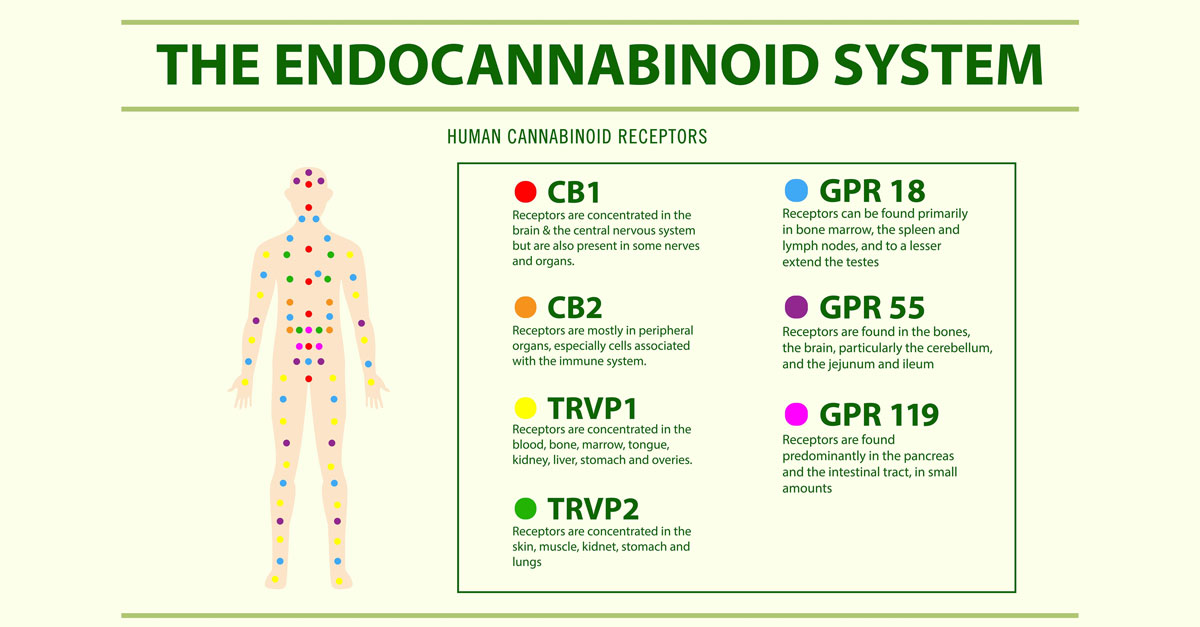Your Amazing Endocannabinoid System

The endocannabinoid system is an entire neural network system in our brains and bodies that we didn’t know existed until we started using cannabis. That’s right, marijuana has immensly helped us to understand more of how our brains work.
The endocannabinoid system (ECS) is a complex cell-signaling system that has been found to play a role in things like sleep, mood, appetite, memory, reproduction, and fertility. In fact, by regulating all biological activities, the ECS is in charge of preserving homeostasis throughout the body!
A 2005 publication titled “The Endocannabinoid System: Physiology and Pharmacology” defined the ECS as “… a ubiquitous lipid signaling system that appeared early in evolution and which has important regulatory functions throughout the body in all vertebrates.”
In this week’s article, we take a look at what the ECS is in layman’s terms. Let’s look at how it was discovered and how it works in a way that anyone can understand without having a Ph.D. in neuroscience.
The Discovery of the Endocannabinoid System
One of the best accounts of the discovery of the ECS was an article written by Martin A. Lee published in 2010. In it, he describes how The National Institute on Drug Abuse accidentally fostered a sequence of key discoveries regarding the workings of the human brain. Lee wrote that in 1988, “a U.S.-government-funded study at the St. Louis University School of Medicine determined that the mammalian brain has receptor sites —specialized protein molecules embedded in cell membranes— that respond pharmacologically to compounds in marijuana resin.”
Simply put: this study showed us that THC (and cannabinoids) affected a specific system in our brains that we didn’t know existed. It was shown that these receptors outnumber any other neurotransmitter in the brain! They were named the CB1 receptors.
Then in 1993, another THC-sensitive receptor was discovered in the immune and nervous systems. These were dubbed the CB2 receptors. They are usually found in the heart, blood arteries, kidneys, bones, gut, reproductive organs, and lymph cells.
Ultimately, researchers were able to put together the presence of the endocannabinoid system by working backward. By first uncovering THC, then receptors, and finally endocannabinoids made inside the human brain and body.
How The Endocannabinoid System Works
So what is the endocannabinoid system and how does it work in our brains? The ECS is made up of three important components: receptors, enzymes, and neurotransmitters (endocannabinoids).
Neurotransmitters – Endocannabinoids
Neurotransmitters are chemical messengers that transfer signals between nerve cells in the body. Endocannabinoids are naturally occurring lipid-based neurotransmitters. They are also known as endogenous cannabinoids. They are similar to cannabinoids, except they are created by your body.
Receptors
Endocannabinoid receptors are present all over your body and in your brain. Endocannabinoids attach to these receptors to indicate that the ECS needs to respond. There are two types of endocannabinoid receptors: CB1 receptors (primarily present in the central nervous system) and CB2 receptors (mostly found in your immune cells). Endocannabinoids can bind to either receptor. The effects depend on where the receptor is placed and which endocannabinoid it binds to.
In Lee’s article, he described it this way: “The cannabinoid receptors function as subtle sensing devices, tiny vibrating scanners perpetually primed to pick up biochemical cues that flow through fluids surrounding each cell.”
Enzymes
Enzymes are in charge of breaking down endocannabinoids after they have served their purpose. Much like the enzymes we have in our gut that break down food, we have enzymes to break down endocannabinoids. In a way, they act as sanitary cleaners. They metabolize the endocannabinoids.
What The Endocannabinoid System Does
Endocannabinoid neurotransmitters, receptors, and enzymes work together to form the complicated cell-signaling system that is the ECS. Its primary purpose is to keep the body’s environment stabilized. In other words, the ECS’s objective is to preserve homeostasis on a molecular level within the body.
According to medical professionals, a vast majority of chronic disorders are possibly caused by Clinical Endocannabinoid Deficiency (CED). The hypothesis that CED is the root cause of many chronic diseases supports the use of cannabinoids like CBD as a therapeutic strategy.
Lee wrote: “ By stimulating CB1 and CB2 receptor signaling, marijuana functions as a substitute “retrograde messenger” that mimics the way our bodies try to maintain balance. Cannabis is a unique, natural medicine that taps into how we work biologically on a very deep level. Thanks to this plant, scientists have been able to decipher the primordial language that nerves and brain cells use to communicate.”
In conclusion, one could say that our bodies were made for cannabis. When there is a shortfall or our bodies want a boost, cannabis can offer us the required cannabinoids that support the endocannabinoid system.
The scientific study of cannabis is rapidly growing along with the booming industry and we expect to learn much more about the ECS and the way cannabis works in the future. It will be fascinating to see what new research shows us as to how much cannabis can positively impact our biologies.
For the official science – pharmacology and physiology of the endocannabinoid system, check out the 2005 publication in Alcohol & Alcoholism journal. It is, perhaps, the most in-depth official peer-reviewed report on the ECS today.
**The statements made within this article have not been evaluated by the Food and Drug Administration. These statements and the products discussed are not intended to diagnose, treat, cure or prevent any disease.
Latest GreenCore News
Going Green: The Rise of Sustainable Cannabis Practices
Going Green: The Rise of Sustainable Cannabis Practices The cannabis market in North America is set to explode, growing from $9.2 billion in 2017 to an expected $50 billion in the next ten years. Global spending on cannabis has also hit new peaks, drawing attention to...
Master Tips For Home Cannabis Cultivation
Master Tips For Home Cannabis Cultivation Spring has arrived, beckoning the season of seed-starting. Whether you're nurturing your green indoors or amidst the great outdoors, whether you're a novice or a seasoned hand at cultivation, there's always room to glean some...
High-Tech Highs: Cannabis Cultivation Innovations
High-Tech Highs: Cannabis Cultivation Innovations Technology has transformed the cannabis industry and it is constantly evolving. From innovative vape products to cutting-edge services, we are getting higher than ever. In our article: Revolutionary New Cannabis...
Contact Us
Office Location
1600 Golf Road, Suite 1200
Rolling Meadows, IL 60008
Office Hours
M-F: 8am - 6pm
Phone
847-201-4600



